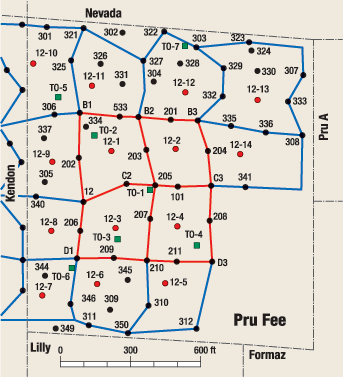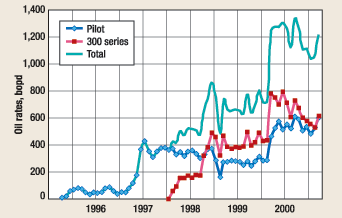Innovative steamflood revives shut-in heavy oil property
Innovative steamflood revives shut-in heavy oil propertySteven Schamel,* Petroleum Research Center, University of Utah, Salt Lake City, Utah; Mike Deets,** Aera Energy LLC, Bakersfield, Calif.; and Viola Rawn-Schatzinger,*** RMC Consultants Inc., Tulsa, Okla. Bottom line. Aera Energy LLC (Aera) successfully reestablished production in the Monarch sand in its Pru Fee lease in the Midway-Sunset field through tight integration of geologic characterization, geostatistical modeling, reservoir simulation and petroleum engineering. Behind the success is an innovative approach to steamflood production design that balances optimal total oil production against economically viable production rates and performance factors. Production on the 40-acre property has risen to over 1,200 bopd and, five years after project start, more than one million bbl of oil has been recovered. Aera is applying concepts learned through this project to adjoining leases. Problem addressed. Aera’s Pru Fee lease had been shut-in since the mid-1980s as economically marginal using conventional cyclic steaming methods. The upper Miocene Monarch sand reservoir has a thick oil column, but a shallow dip (10°) that inhibits gravity drainage, ineffective steam barriers within the pay interval and a thick, water-saturated transition zone above the oil-water contact (OWC) that made conventional steam flooding marginal. A thorough, truly integrated team effort was required to find the key to unlock performance under these conditions. Lease history leads to DOE Class 3 project. Commercial production began on the Pru Fee property in the early 1900s, with primary production continuing until 1969, when Tenneco initiated infill drilling and cyclic steaming. During the more than 50 years of primary production, nearly 1.8 million bbl of oil had been produced. When cyclic steaming was started in 1969, primary production had fallen to insignificant levels. Cyclic steaming of the 13°API oil was partially successful, recovering an additional 600 thousand bbl of oil and initially raising production to 300 bopd. But production had declined to less than 10 bopd when the lease was shut-in in 1986 as uneconomic. A project to reactivate the shut-in Pru Fee property by the University of Utah and ARCO Western Energy (AWE) was selected for a DOE Class 3 demonstration project in mid-1995, with work started in late 1995. Initially, the plan called for the renovation of old wells and cyclic production facilities, plus the drilling of two new wells, Fig. 1. Pru 101, one of the new wells, was cored, steam-stimulated, then put into cyclic production. Several old wells in the center of the property were recompleted and put into cyclic production. These efforts, together with thorough reservoir characterization and production simulation, demonstrated the feasibility of proceeding with a steam-flood pilot.
In January 1997, the project was expanded with the completion of 11 new producers, four injectors and three temperature-observation wells, making an 8-acre, nine-spot, four-pattern pilot. Steamflood production of the pilot began in January 1997. Early production success of the pilot led AWE to expand operations across the lease with 37 additional wells (300-series) put on line in 1998 and early 1999. Initially, these wells were produced in cyclic mode. Aera took over the Pru Fee lease from AWE in October 1998, and began operating on January 1, 1999. Aera moved actively to complete the development work begun by AWE by drilling 14 wells required to develop 10 additional steam flood patterns, and adding additional steam generation capacity on-site. By early 2000, nearly the entire property was being produced by steamflood, following most of the design standards of the initial pilot. Reservoir characteristics and production strategy. Average Monarch Sand reservoir characteristics are 31% porosity and 2,250-md permeability. The initial 1995 average oil saturation was estimated to be 59% based on the nearly complete core from Pru 101. However, almost all wells have a transition zone more than 100 ft thick of downward-decreasing oil saturation in the bottom half of the pay interval. Wireline logs suggest that the sand is essentially a single sand body with interspersed, discontinuous remnants of diatomite beds. Although the reservoir is quite homogeneous, oil saturation exhibits significant lateral, as well as vertical, variability. Reservoir simulations revealed that the initial fluid distribution has the most significant impact on steamflood economics. The strategy adopted for the pilot was to target steam injection to the upper one-third to one-half of the oil column where oil saturation is greater than 50%. When data from wells drilled for the "300-series" expansion indicated that the initial oil saturation was more variable than thought, steam injection points were placed in the upper two-thirds of pay intervals. In retrospect, the steam injection string may be too deep in several injectors. Prior standard practice had been to inject steam into the deeper parts of the oil column, believing that steam would quickly rise to the top. Experience within the project indicates that steam stays rather close to the stratigraphic intervals in which it is injected. Variations in production. The per-well oil rates vary widely across the 40-acre lease, but on whole, they are substantially higher in the pilot patterns than in the "300-series" patterns. The principal reason that the pilot wells outperform those of the surrounding patterns is that the former are gravel packed, whereas the "300-series" wells were completed bare, without gravel pack. Additional contributing factors include the fact than many of the "300-series" patterns are in portions of the property depleted by prior or adjacent production activity, and many of the new injectors are perforated a bit too deep, resulting in less than optimal placement of heat. Production response from the pilot area, the "300-series" area and overall composite is shown in Fig. 2. The figure shows the initial production surge from steamflooding in the initial four-pattern pilot in early 1997, plus a second surge when the "300 series" area was converted from cyclic to steamflood in early 2000. Recent production history reflects additional stimulation of pilot wells by aggressive steam injection in the surrounding "300 series" patterns. The oil rate increase for the pilot is expected to continue, while the patterns on the east and south of the pilot warm sufficiently to contribute.
It is significant that – even with exceptionally high gas prices in California in early 2001, which forced shut-in of many thermal operations – the Pru Fee lease continued to operate profitably. In March 2001, after five years of steamflood operation, more than one million bbl of oil, representing 9.8% of the original oil in place, had been recovered from the Monarch sand. Technology taken to adjoining leases. Observing the manner in which the injectors in the Pru Fee pilot were completed, Aera adopted the concept of a large stand-off from the OWC in injector workovers in the low-dip portion of the Kendon lease, immediately west of Pru Fee. New perforations there were placed in the uppermost one-third to one-half of the Monarch sand and deeper existing perforations sealed. Reported response has been outstanding. In addition, Aera is now developing the Lilly property immediately south of Pru Fee using the same injector completion strategy. PTD Acknowledgments Information for this article was abstracted from an extensive article published in the Summer 2001 issue of DOE’s The Class Act newsletter, which can be accessed through DOE’s National Petroleum Technology Office website (http://www.npto.doe.gov/CA/CASum2001.pdf). It is also acknowledged that without the incremental funding from the DOE Class 3 program, the Pru Fee lease would likely never have been reactivated.
|
||||||||||||||||||||||||||||
- What's new in production (February 2024)
- Prices and governmental policies combine to stymie Canadian upstream growth (February 2024)
- U.S. operators reduce activity as crude prices plunge (February 2024)
- U.S. producing gas wells increase despite low prices (February 2024)
- U.S. drilling: More of the same expected (February 2024)
- U.S. oil and natural gas production hits record highs (February 2024)
- Applying ultra-deep LWD resistivity technology successfully in a SAGD operation (May 2019)
- Adoption of wireless intelligent completions advances (May 2019)
- Majors double down as takeaway crunch eases (April 2019)
- What’s new in well logging and formation evaluation (April 2019)
- Qualification of a 20,000-psi subsea BOP: A collaborative approach (February 2019)
- ConocoPhillips’ Greg Leveille sees rapid trajectory of technical advancement continuing (February 2019)




